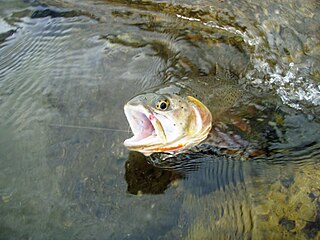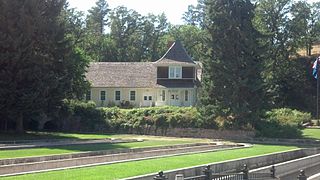
The cutthroat trout(Oncorhynchus clarkii) is a fish species of the family Salmonidae native to cold-water tributaries of the Pacific Ocean, Rocky Mountains, and Great Basin in North America. As a member of the genus Oncorhynchus, it is one of the Pacific trout, a group that includes the widely distributed rainbow trout. Cutthroat trout are popular gamefish, especially among anglers who enjoy fly fishing. The common name "cutthroat" refers to the distinctive red coloration on the underside of the lower jaw. The specific name clarkii was given to honor explorer William Clark, coleader of the Lewis and Clark Expedition.

Fish stocking is the practice of raising fish in a hatchery and releasing them into a river, lake, or ocean to supplement existing populations or to create a population where none exists. Stocking may be done for the benefit of commercial, recreational, or tribal fishing, but may also be done to restore or increase a population of threatened or endangered fish in a body of water closed to fishing.

A cutbow is an interspecific fertile hybrid between a rainbow trout and a cutthroat trout. Cutbow hybrids may occur naturally where the native ranges of both species overlap--coastal rainbow trout and coastal cutthroat trout and Columbia River redband trout and westslope cutthroat trout. However, natural separation of spawning habitat limited hybridization in most native populations of rainbows and cutthroats. Introduction of non-native hatchery raised rainbow trout into the native ranges of cutthroat subspecies increased the rate of hybridization. Some native cutthroat populations are at risk due to genetic pollution.

The D.C. Booth Historic National Fish Hatchery and Archives, also known as the Spearfish Fisheries Center or Spearfish Fisheries Complex and formerly known as the Spearfish National Fish Hatchery, is one of 70 fish hatcheries that were opened by the U.S. Fish and Wildlife Service as part of the National Fish Hatchery System. The hatchery was established near Spearfish, South Dakota in 1896, with the purpose of introducing and establishing populations of trout in the Black Hills of South Dakota and Wyoming. It is one of the oldest fish hatcheries in the United States and is the second-oldest in the American West. The hatchery spawns and releases about 20,000 to 30,000 rainbow trout each year. The hatchery doubles as a fisheries archive with the purpose of preserving records and early historical artifacts. It is listed on the National Register of Historic Places.

Saratoga National Fish Hatchery is part of the National Fish Hatchery System operated by the United States Fish and Wildlife Service. It is located northeast of Saratoga, Wyoming and, along with the Jackson National Fish Hatchery, is one of two National fish hatcheries operating in Wyoming. Saratoga NHF is primarily a broodstock hatchery; it maintains several healthy adults to produce sperm and eggs and distributes fertilized eggs to production hatcheries throughout the country to be hatched and grown to stockable sizes. It is also one of several organizations to establish a program for breeding Wyoming toads.
Crystal Lake Hatchery is located in Cassel California, a small town in Northeastern California.

The Bellvue-Watson Fish Hatchery is a Colorado Parks and Wildlife cold water fish production facility located near Cache la Poudre River and Watson Lake State Wildlife Area in Larimer County, Colorado. Hatchery staff works to support the raising of approximately 1.5 million sub-catchable trout annually. The Watson Lake Rearing Unit, a division within the hatchery, is responsible for rearing approximately 300,000 catchable trout each year. The hatchery stocks fishing sports in Wellington, Fort Collins, Loveland, Longmont and Jumbo Reservoir near Julesburg and Hale ponds.

The Crystal River Hatchery is a Colorado Parks and Wildlife cold-water fish production facility located along the Crystal River in Garfield County, Colorado, near Carbondale. The hatchery raises rainbow trout and Snake River cutthroat trout brood fish. The millions of eggs from these brood fish are shipped to other hatcheries to be raised for stocking.

The Finger Rock Rearing Unit is a Colorado Parks and Wildlife cold water fish production facility located near Bear River in Routt County at the base of Flat Tops Wilderness Area.

The Glenwood Springs Hatchery is a Colorado Parks and Wildlife cold water fish production facility located on Mitchell Creek near the Colorado River in Garfield County, which is 2 miles north of West Glenwood Springs.

The John W. Mumma Native Aquatic Species Restoration Facility is a Colorado Parks and Wildlife cold water fish production facility located near Playa Blanca State Wildlife Area and Rio Grande river in Alamosa County.

The Mt. Shavano Hatchery is a Colorado Parks and Wildlife cold water fish production facility located near Arkansas River headwaters at the base of Big Baldy Mountain in Chaffee County. This facility is considered one of the largest trout units in the state.

The Pitkin Hatchery is a Colorado Parks and Wildlife cold water fish production facility located in Gunnison National Forest right off of Quartz Creek Valley in Gunnison County.

The Poudre Rearing Unit is a Colorado Parks and Wildlife cold water fish production facility located near Cache la Poudre River at the base of South Bald Mountain in Larimer County. It is considered one of the smaller units in Colorado.

The Pueblo Hatchery is the only Colorado Parks and Wildlife cold and warm water fish production facility located in Lake Pueblo State Park near Arkansas River in Pueblo County.

The Rifle Falls Fish Hatchery is a Colorado Parks and Wildlife cold water fish production facility located off East Rifle Creek near Rifle Falls State Park in Garfield County.

The Roaring Judy Hatchery is a Colorado Parks and Wildlife cold water fish production facility located on East River at the base of Flat Top mountain in Gunnison County. It home to the largest known kokanee salmon run in Colorado.

The Wray Fish Hatchery is a Colorado Parks and Wildlife warm and cold water fish production facility located near Chief Creek and Stalker Lake in Yuma County.











